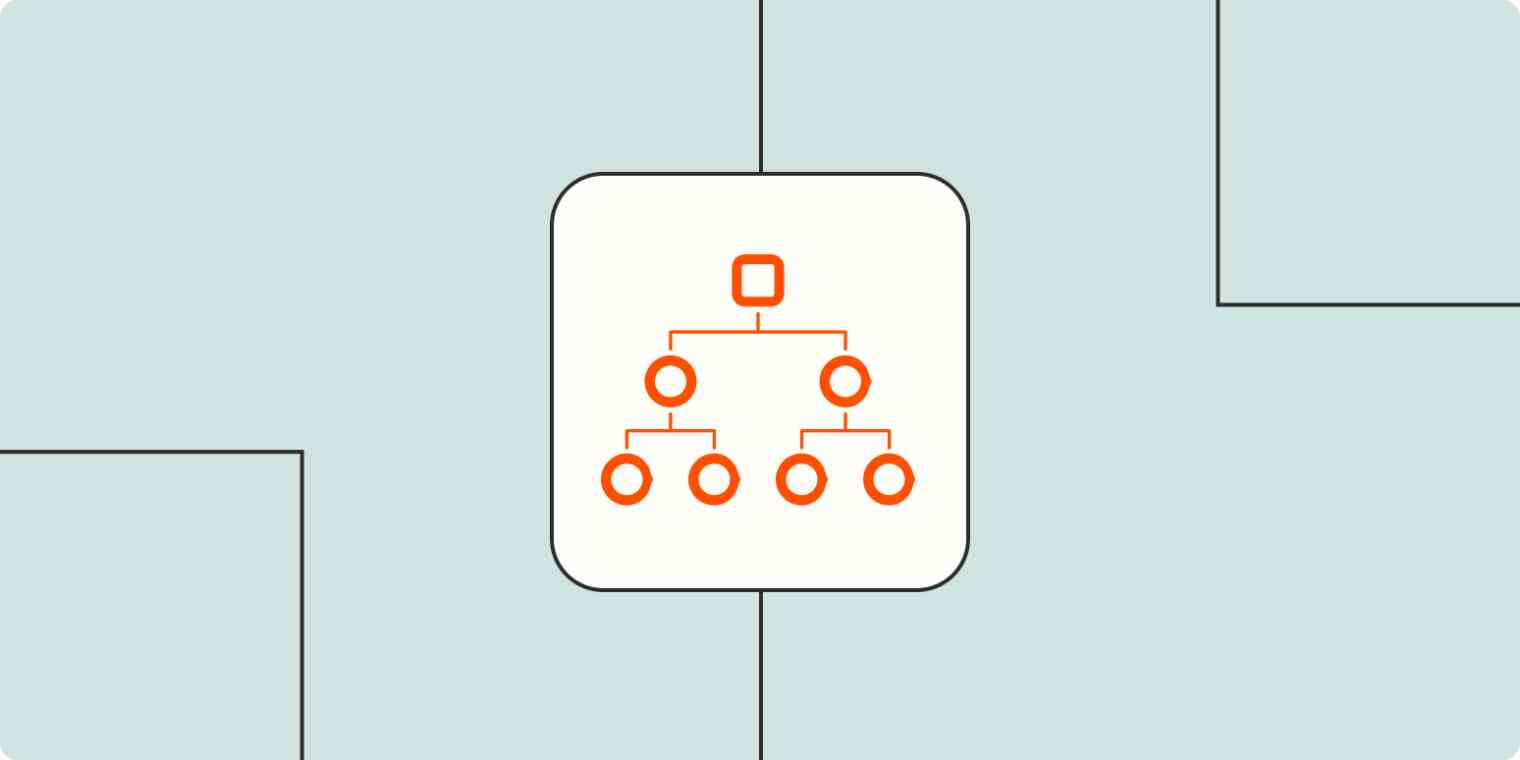Back in high school, I was the drummer for our jazz band, which was a lot like being at the bottom of an organizational chart. Tucked away at the back of the stage, it was my thankless duty to count measures for everyone else. While the others got the limelight, I only got the privilege of hauling my drum kit to and from gigs.
No matter where you land on an org chart, they're a vital tool for mapping the structure of your organization. Feel free to dive right into our collection of org chart templates to find the perfect fit, or stick around for insight on how they can streamline your business processes and enhance team dynamics.
Table of contents:
What is an organizational chart?
An organizational chart, or org chart, is a diagram of a company's internal structure. It outlines the roles, responsibilities, and relationships between employees and departments. It's a snapshot of the hierarchy in an organization, showing who's boss, who's almost boss, and who's absolutely not the boss.
In addition to being a visualization of your company's structure, there are lots of benefits of implementing an org chart:
Removes ambiguity: Not having an org chart is like being lost in an unfamiliar forest—you're just wandering around, asking woodland creatures who your new direct report is. The org chart is a roadmap to understanding who does what, who answers to whom, and who to butter up for a good parking spot.
Improves communication: An org chart streamlines communication by showing you the direct line to the person you need, avoiding that awkward game of corporate telephone where you ask for budget approval and end up signing up for the company talent show.
Fosters a healthier community: An org chart helps employees understand their role within the larger group, creating a sense of belonging. When roles and relationships are clear, there's less chance of stepping on toes or accidentally sending your "sick day" beach selfie to your boss's boss's boss.
Serves as a planning tool: Org charts help you evaluate where you can add new roles, where the gaps are in your team, and where future management bottlenecks are waiting to ambush your operational flow. New hires can also use org charts to understand possible career paths.
Why use a template for an organizational chart?
An org chart template offers an easy way to create a professional organizational chart without investing much time or money. With some simple edits, a good template can work wonders for visualizing your company's structure and reporting relationships.
Saves time: Templates provide a premade structure, allowing you to plug in information without having to fuss with aligning boxes, choosing fonts, or picking color schemes. The predesigned layout lets you quickly assemble a professional-looking org chart in minutes. This is especially handy for small businesses or startups where resources are limited.
Consistent design: Templates ensure that all organizational charts within a company follow a uniform style, making it easier for employees and stakeholders to navigate.
Easy to update: Most templates are user-friendly and designed for individuals without extensive graphic design skills. A template simplifies the process, allowing team leaders or managers to create or update org charts without specialized knowledge or software.
Standardized information: A template can help standardize org charts across different departments or branches. If your company operates in multiple locations, a template keeps everyone on the same page.
With some time invested upfront, an organizational chart template will become an indispensable resource for onboarding new hires, planning reorgs, and keeping everyone aligned on roles and responsibilities.
15 free templates for an organizational chart
There are plenty of free and paid org chart software options out there—if you're looking for something that will scale, start there. But these templates are the perfect fit if you're looking for a no-cost, one-time solution to map out your team's structure.
These templates are predominantly designed for Google Sheets, with a select few available in Google Slides format for more visually-driven org charts.
1. Hierarchical org chart template

Best for: Organizations looking for clear, structured lines of authority and responsibility
A hierarchical org chart depicts how each role relates to one another in a basic, vertical structure. It's the most common type of organizational chart, sometimes called a functional top-down org chart.
The higher up the chart a role is, the more authority it holds. This clear chain of command helps define accountability within the company. It's like Thanksgiving with my family—structured, predictable, and someone always has to sit at the kids' table, even if they have 30+ years of experience.
However, a hierarchical org chart fails to capture cross-departmental relationships, temporary task forces, or the informal connections between coworkers who often collaborate. Its many layers and bureaucratic nature may also slow down decision-making and innovation.
2. Matrix org chart template
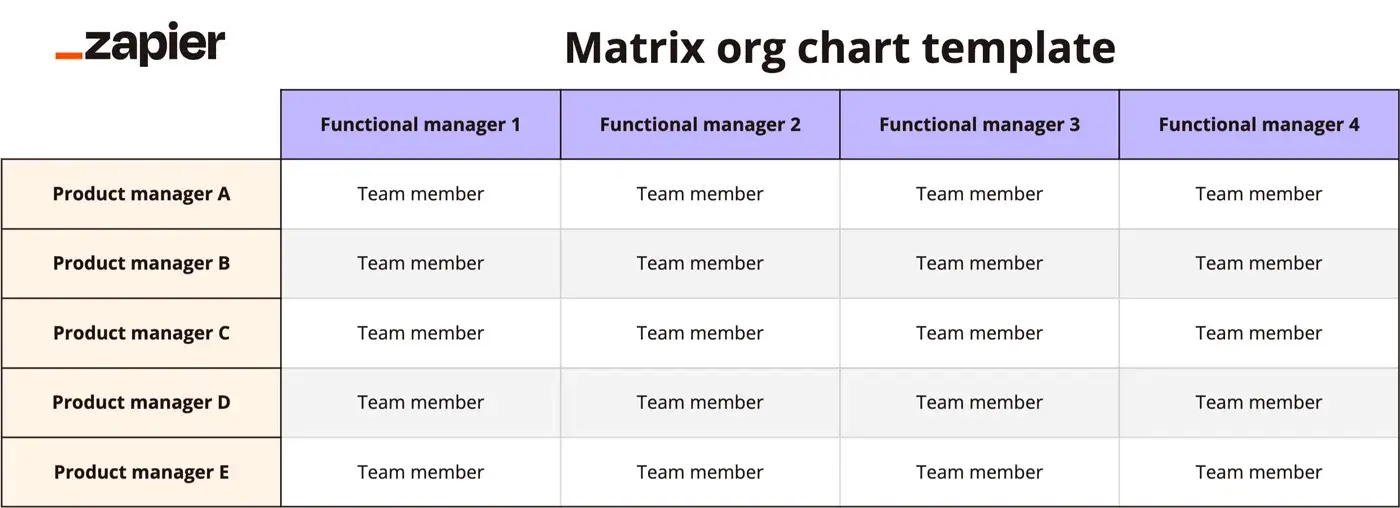
Best for: Complex organizations with clear management processes and solid interdepartmental collaboration
A matrix org chart combines two or more organizational structures, typically by function and by project or product. Instead of a traditional top-down hierarchy, employees report to both a functional manager and a product or project manager. It's a bit like having a strict parent and a cool parent, but in the office.
The structure forms a grid, with vertical lines representing functional responsibilities (like finance, marketing, etc.) and horizontal lines for different products or projects. This type of structure recognizes that people can wear multiple hats, but it also often leads to power struggles, conflicting priorities, and general chaos. Project managers and functional managers must be in close contact to ensure team members receive consistent guidance.
A matrix org chart is a lot like the movie "The Matrix." But instead of dodging bullets in slow motion or wearing sunglasses in dimly lit rooms, you're constantly adapting to shifting organizational realities. (I've never seen "The Matrix.")
3. Divisional org chart template
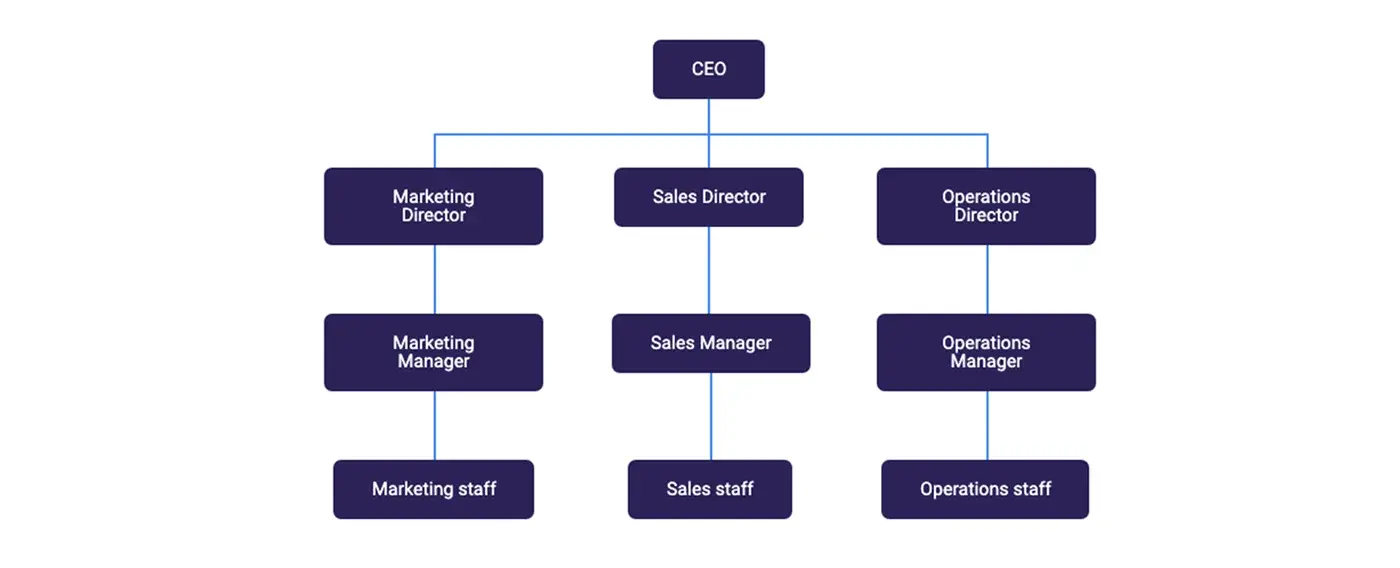
Best for: Breaking down an organization into smaller, more manageable subunits
A divisional org chart groups employees according to the product, market, or business function they contribute to. Rather than reporting to top-level management, employees report to division heads, who report directly to top executives. Divisional org charts prevent higher-ups from being bogged down in day-to-day minutiae.
Of course, some downsides exist. Divisional org charts can lead to unhealthy internal competition and a lack of cooperation across divisions. They also require strong leadership to avoid divisions becoming too powerful. However, for large companies selling diverse products, a divisional structure is an excellent way to stay organized without suffering bureaucratic paralysis.
4. Multidivisional org chart template

Best for: Large companies with many business units
A multidivisional chart takes the divisional concept further, treating divisions as individual entities with their own functional departments. Each division operates like its own company, with leadership and staff overseeing key business areas like product development, marketing, finance, and operations. The multidivisional structure allows each unit to focus on its specific products, customers, and regions.
This org chart comes with challenges, like the potential for lack of communication across units and duplicated resources. But with the proper management and strategic oversight, this flexible model empowers large companies to operate with an entrepreneurial spirit.
5. Flat org chart template

Best for: Startups and smaller companies aiming to enhance creativity, communication, and employee empowerment
As the name suggests, a flat org chart depicts a horizontal structure with few levels of management and minimal bureaucracy. With no pesky hierarchies or chain of command to slow things down, you're free to shortcut straight to the top. Or bottom. Or middle.
With a flat structure, communication lines are short, and employees often interact directly with executives. This can lead to faster decision-making and greater flexibility. However, as companies grow, flat org charts can become unwieldy without proper controls and policies in place. This doesn't mean large companies can't have a flat organizational structure—Valve is famously flat—but these org charts work best for small startups that encourage maximum creativity and risk-taking.
But be prepared for the chaos that can ensue when no clear leader is calling the shots. Without assigned levels of responsibility, you never know who's actually in charge of any given task. And because everyone's opinion matters, meetings can feel like an open mic night. Or worse, a never-ending filibuster where you start wondering if you'll ever see your family and friends again.
6. Function-based org chart template

Best for: Organizations that value efficiency over creativity or in a highly regulated industry
A function-based org chart groups employees based on their common expertise, not by department or reporting line. This can be an effective way to visualize teams that cross departments or span locations.
This type of org chart shows how work flows between departments based on individuals' specific functions and roles. It's ideal for clarifying who does what and avoiding turf wars.
While a function-based org chart is excellent at making everyone a master of their own domain, it can become a bit of a juggling act if the organization starts throwing more balls in the air. And its rigid structure can be stifling for innovative thinkers.
7. Project-based org chart template

Best for: Organizations with large and complex project-based initiatives
A project-based org chart outlines the structure of a specific project rather than an entire company. It shows the key roles and reporting relationships needed to complete a project successfully.
Extremely useful for complex or long-term projects, project org charts empower teams by defining their scope of work. A project-based structure also makes it easy to spot initiatives that may need more (or fewer) resources.
8. Network org chart template
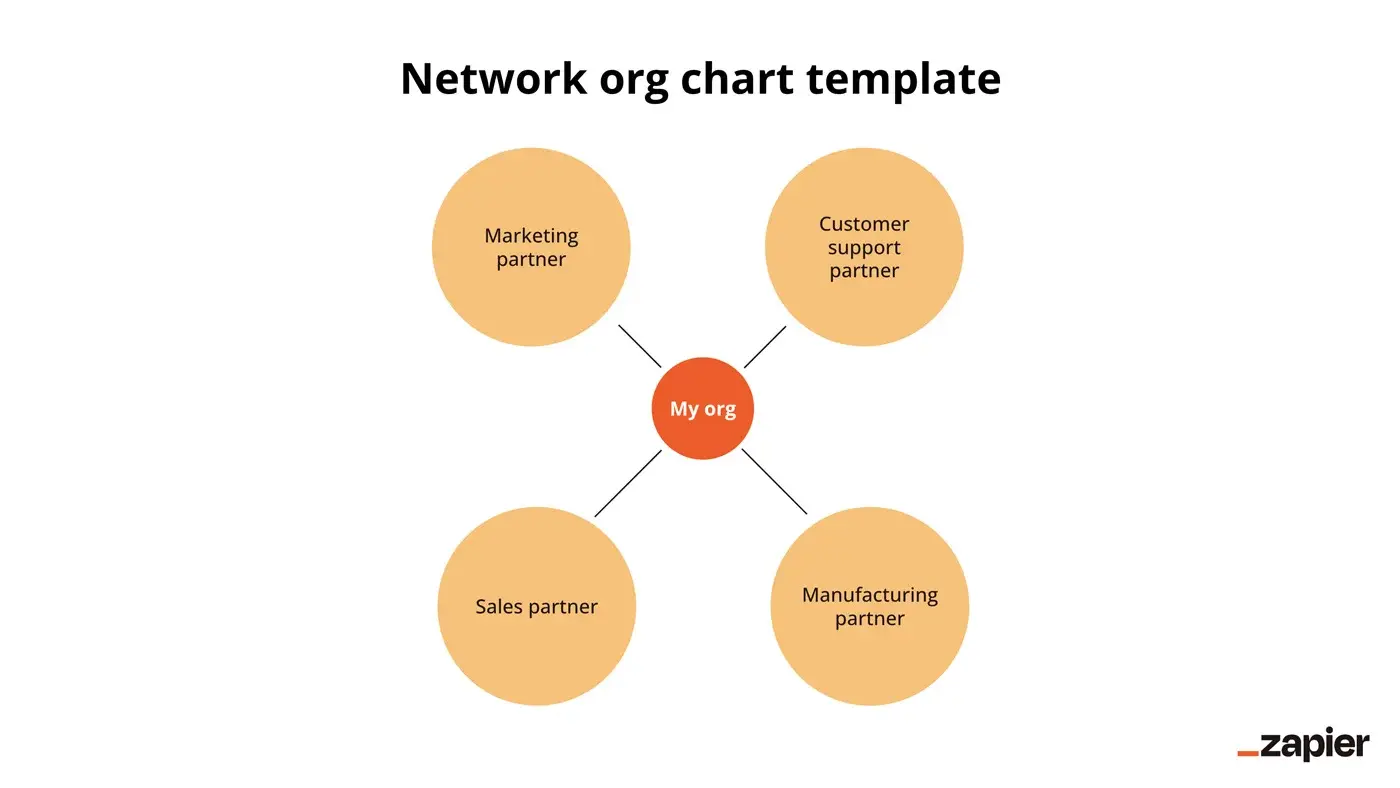
Best for: Organizations interested in decreasing overhead or removing inefficient roles
No strict hierarchy here—network org charts coordinate activities through a cluster of different companies. This method allows organizations to outsource functions like marketing or manufacturing to external partners who specialize in these areas.
Issues like coordination and trust can be significant hurdles in a network model. Also, the contractual nature of these networks might discourage long-term investments or information sharing by partners, potentially impacting the network's effectiveness.
9. Inverted org chart template
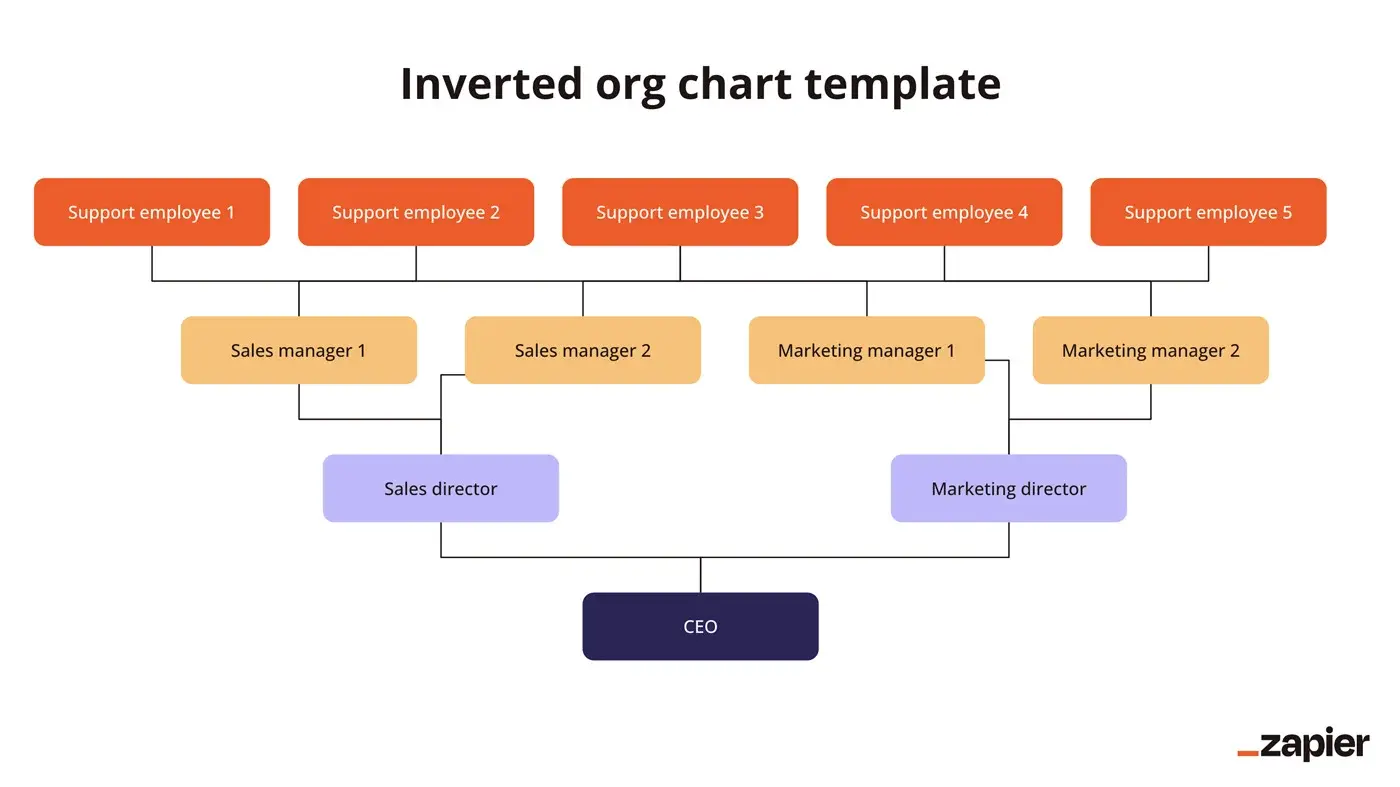
Best for: Companies looking to prioritize frontline employees
An inverted org chart flips the traditional hierarchy on its head. Instead of having all power and decision-making at the top, it empowers employees at all levels.
In an inverted org chart, the CEO and executives are at the bottom, supporting the frontline workers above them. The employees who directly serve customers and get their hands dirty with the day-to-day work have more authority and autonomy.
Rather than issuing orders from an ivory tower, leadership takes on more of a coaching role. They ask frontline teams what they need to do their jobs effectively and work to enable their success. The executives are there to facilitate, not dictate.
10. Product-based org chart template

Best for: Organizations with many product divisions
A product-based org chart follows a divisional structure that groups products into separate divisions. It depicts the key roles and reporting relationships that enable the team to build and improve products effectively. This model allows for focused product development, improved efficiency, and rapid innovation.
However, each product division has its own set of specialists, and while that's great for focus, it can lead to redundancy. It's like having a kitchen gadget for every conceivable task. Owning a banana slicer, an avocado pitter, and an egg separator is fun, but soon you're wondering how a non-archaeologist can find the citrus zester in the buried ruins of your utensil drawer. As voice-of-a-generation Alanis Morissette said, it's like having 10,000 spoons when all you need is a knife. (I'm fairly certain that song is about org charts.)
11. Geographic org chart template

Best for: Companies with offices in multiple cities, states, or countries
A geographic org chart depicts an organization's structure based on physical locations such as regions, states, or countries.
A geographic org chart provides a straightforward visual representation of how your organization's physical footprint aligns with its leadership and reporting structure. It helps ensure communication and collaboration flow effectively across the entire company, regardless of location.
12. Customer-centric org chart template

Best for: Customizing divisions around major market segments such as client groups, industries, or population groups
A customer-centric org chart optimizes your operations around the customer experience. It groups employees by the type of customer they serve rather than by job function.
For example, you might have separate divisions focused on:
B2C vs. B2B clients
eCommerce shoppers vs. in-store customers
Long-time loyal customers vs. new prospects
By focusing on a specific customer segment, each team can better understand customer needs and tailor solutions appropriately. This also promotes accountability, as each team is directly responsible for the satisfaction and retention of their designated customers.
13. Hybrid org chart template

Best for: Large, complex organizations with many divisions that can benefit from different organizational structures
A hybrid organizational chart combines two or more types of organizational structures. For example, you may have a multidivisional structure to create self-contained divisions. Then, leadership within each division selects the best structure to manage roles and responsibilities. One division may choose a hierarchical structure, where the higher you are, the less likely you are to know how the printer works. While another division might prefer a flat structure, making decisions over a game of foosball.
A hybrid organizational chart is a useful option for balancing multiple priorities. When thoughtfully designed and implemented, it can help overcome the limitations of a single structure while gaining the benefits of different approaches.
14. Circular org chart template
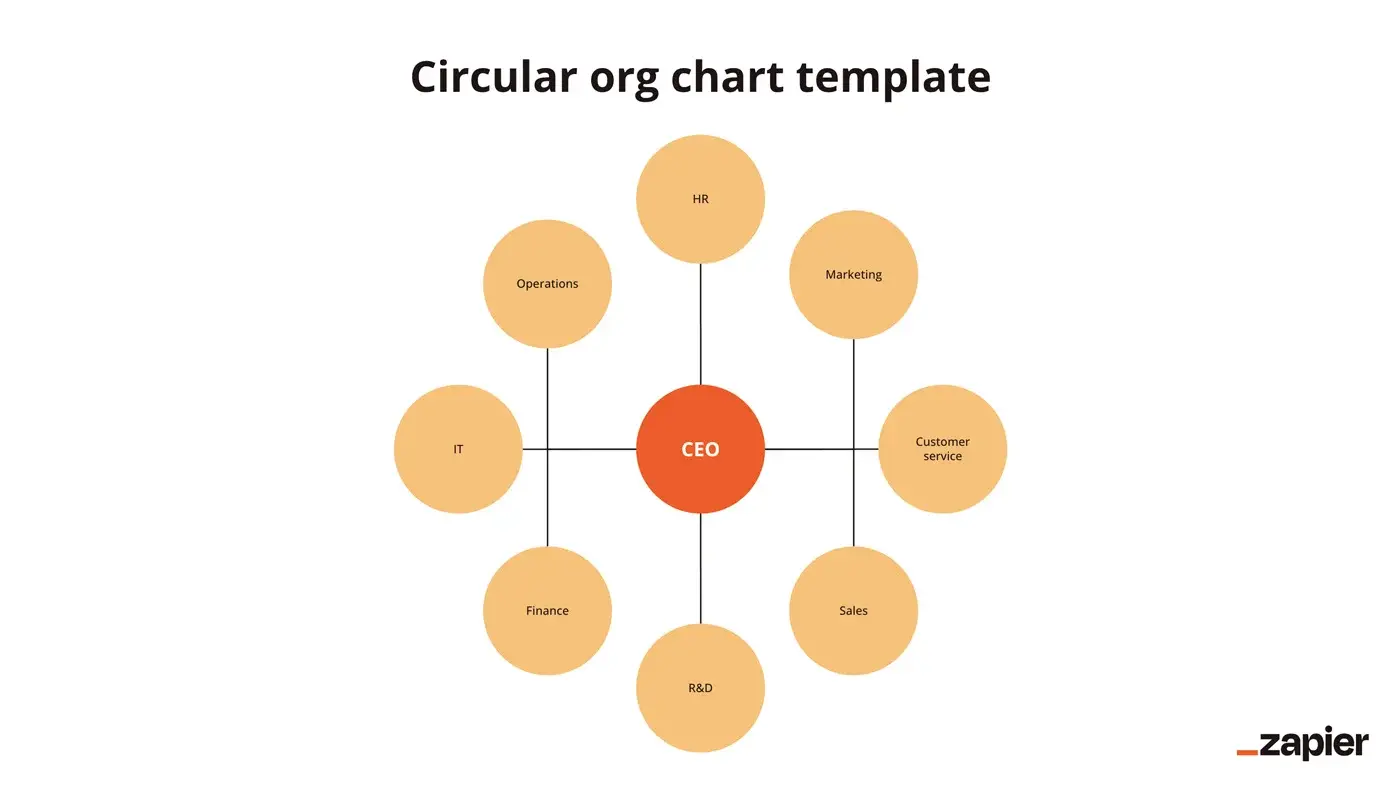
Best for: Companies looking to foster a sense of unity and break down silos
Instead of visualizing a company from the top down in a pyramid-like structure, a circular, or round, org chart is drawn from the center out. The centermost circle represents the company's highest-level officer. The outermost circles represent individual contributors.
Unlike a top-down hierarchy, everyone is equidistant from the center. It's like a round conference room table where everyone has an equal chance to make awkward eye contact with the CEO during meetings. This structure symbolizes unity, collaboration, and equality, which is ironic considering how the entire organization literally orbits around the CEO.
15. Roles and responsibilities org chart template
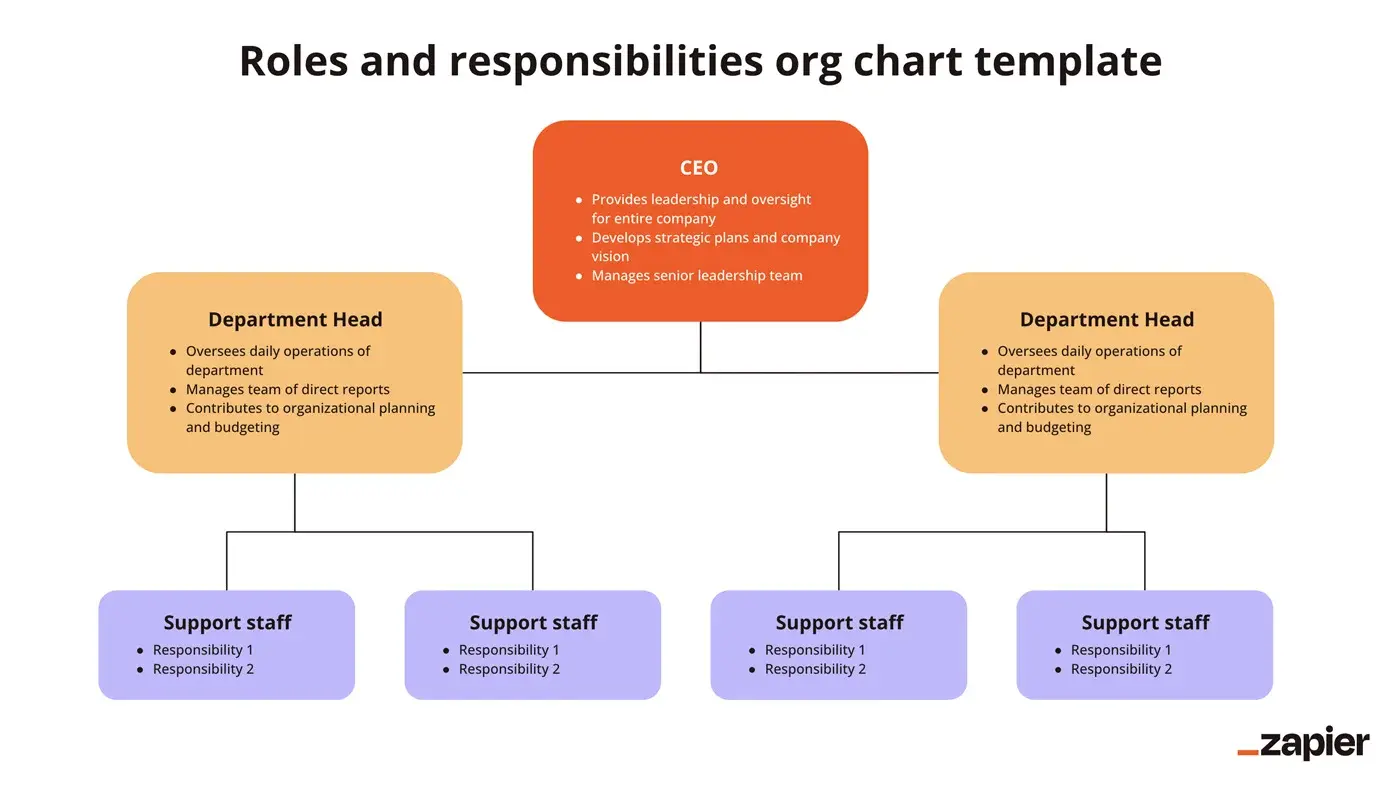
Best for: Clearly defining each position's responsibilities in an organization
A roles and responsibilities org chart outlines each role, who fills it, and their core duties. Like the workplace equivalent of keeping a chore chart on the fridge, this org chart might not be glamorous, but it keeps the peace and ensures everything gets done.
With clearly defined roles, employees know exactly where their responsibilities begin and end. They'll also have a better sense of how their position fits into the overall success of your company, which helps foster collaboration and teamwork.
6 steps to create an org chart template for your organization
An org chart seems straightforward enough, but building one that's clear, useful, and visually appealing is an art form. Follow these steps, and you'll have a professional org chart template ready for your team before you can say "organizational restructuring."
1. Gather information
To create an org chart template, you'll first need to do some legwork. To kick things off, gather details about the roles, titles, and reporting relationships within your organization.
The org chart should reflect the whole organizational hierarchy, not just your little corner of it. How do the design and marketing departments work together? What's the chain of command in finance or IT? Talk to managers and employees to understand the hierarchy and how different departments interact.
For each role, include the official job title, how many employees, and a brief description of primary duties. Also, note any vacant positions so you can keep the chart up-to-date as new hires come on board.
2. Select the org chart format
Once you have the key areas and positions mapped out, it's time to determine how you want to visualize the information.
Traditional hierarchies can mean clear direction but maybe less freedom to challenge the status quo. Modern, flat structures can be empowering, but sometimes you wish someone would just decide which project to prioritize instead of opening it up for a 30-person debate.
The type of organizational chart you choose depends on factors like company size, corporate structure, and business goals. Experiment with different templates to find one that maximizes efficiency, empowerment, and productivity within your organization.
In the end, think about what fits your culture best. An org chart should clarify roles and responsibilities, not send people searching for a stiff drink. The ideal org chart will evolve as your company grows and priorities change.
3. Choose a template or tool
It's time to choose how you want to create your org chart template. You've got a few options here.
Online templates
If you want a simple, low-tech solution, find a free template (hint: scroll up) and use a word processor like Microsoft Word or Google Docs, a spreadsheet program like Microsoft Excel or Google Sheets, or a presentation program like PowerPoint or Google Slides. Just open the file, input departments, names, and roles, and you're done. Zero design skills required.
While convenient, the downside is that the template may not perfectly suit your needs. But when you need a quick and dirty chart, a template can't be beat.
Specialty software
For more advanced options, consider flowchart software like Lucidchart or Creately. These tools give you more flexibility to create exactly the look you want. You can choose from loads of templates and then customize the heck out of them. The end result looks far more professional than any standard template.
The only downside is the learning curve. Even if the software isn't too complicated, it may take an hour or two to get comfortable with all the options.
Ultimately, you need to weigh how much control and customization you want over your org chart versus how much time you're willing to put into creating it. Templates keep it simple, while software gives you more power and flexibility. Choose the option that fits your needs and technical abilities.
4. Create the chart structure
The structure of your org chart is the foundation. Place the highest role, like CEO or Dear Leader, at the top (unless you're creating an inverted chart). Then add the next level down, followed by subsequent levels below that. Use connecting lines to show which positions report to others.
Keep drilling down within each department until you've mapped out the entire organizational hierarchy. But only include roles and relationships that are directly relevant to the organization's structure. Leave out contractors, temporary employees, and consultants.
5. Format the org chart
Once you have the bare bones of your org chart in place, it's time to make it pretty:
Select colors that match your brand guidelines. Stick to a simple palette of two to three complementary colors for the best results.
Choose one font for the org chart. A simple sans serif font like Arial, Calibri, or Open Sans works best. Be sure the font is large enough to read easily when printed. Using too many fonts can make your org chart look like a ransom note.
Include your organization's logo in the top-left corner of the org chart. Make sure it's large enough to see clearly but not so big that it throws off the balance of the chart. A logo helps reinforce your brand and adds a polished touch.
If desired, you can add photos of leaders or executives in your org chart. Use a square photo that takes up about 1/4 to 1/3 of the node shape. Keep the style consistent—either use photos for all positions or none. Only include photos up to a certain level in the hierarchy. Having too many images can make the chart difficult to read.
Include a legend or key to explain the meaning of any special formatting, like colors representing different departments or dotted vs. solid lines indicating part-time vs. full-time roles. Without an explanation, people may interpret these visuals incorrectly.
6. Review for accuracy and update regularly
Before unleashing your org chart on the unsuspecting masses, it's important to double-check that all the information is correct. Check that everyone's official job title and correct manager are listed. Make sure no one was accidentally omitted or placed in the incorrect department. Check that all lines of authority and the proper reporting relationships are clearly shown.
Once distributed, ask team members to review the org chart and provide any feedback on information that may need to be modified or updated. Be open to suggestions on improving the chart's clarity or accuracy.
Your org chart should be a living document, so set a reminder to revisit it once a quarter to verify the details. Have there been any additions, promotions, or departures in the ranks? Regular reviews and updates help ensure an org chart is a useful resource rather than an outdated document that no longer reflects the actual organizational structure. Make updating the org chart a part of your regular communications and HR processes.
Upgrade to org chart software
If you find yourself editing your org chart more than once or twice, it's probably time to invest in org chart software, or even in HR software that also includes org charts as a feature. That will also allow you to automate your org chart, eliminating the manual work involved in updating roles and titles.
A well-thought-out org chart can be the difference between a smooth-sailing corporate cruise and a "who's steering this thing?" kind of panic. And if you ever find yourself at the bottom of one, just remember: even Oprah was once not a CEO.
Related reading:
